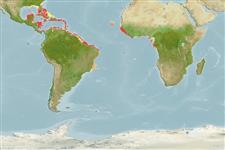Common names from other countries
Environment: milieu / climate zone / depth range / distribution range
Écologie
Récifal; profondeur 0 - 30 m (Ref. 848). Subtropical; 33°N - 25°S, 92°W - 12°E (Ref. 848)
Distribution
Pays | Zones FAO | Écosystèmes | Occurrences | Introductions
Atlantic Ocean.
Length at first maturity / Taille / Poids / Âge
Maturity: Lm ? range ? - ? cm Max length : 5.0 cm COLD mâle / non sexé; (Ref. )
Description synthétique
Morphologie
Colony: small, usually less than 50 mm across, hemispherical to encrusting. Corallites: shape range from immersed to conical to tubular, may be circular with one mouth, to elongate with multiple mouths; intertidal encrusting colonies may be submeandroid; spherical colonies with unrestricted growing space often with tubular corallites; valleys seldom more than 5 mm across; walls neatly rounded, whatever the corallite shape. Septo-costae exsert and evenly spaced. Color: often tan to light orange-brown with pale green tentacles (Ref. 848).
Zooxanthellate (Ref. 116012). Common in shallow less than 15 m; reef habitats and sometimes seagrass beds (Ref. 415). Also in intertidal rock pools and shallow reef environments (Ref. 848).
Life cycle and mating behavior
Maturité | Reproduction | Frai | Œufs | Fécondité | Larves
Hermaphroditic (Ref. 113712). Mature gametes are shed into the coelenteron and spawned through the mouth. Life cycle: The zygote develops into a planktonic planula larva. Metamorphosis begins with early morphogenesis of tentacles, septa and pharynx before larval settlement on the aboral end (Ref. 833).
Collin, R., M.C. Díaz, J. Norenburg, R.M. Rocha, J.A. Sánchez, M. Schulze, A. Schwartz and A. Valdés. 2005. (Ref. 415)
Statut dans la liste rouge de l'IUCN (Ref. 130435)
statut CITES (Ref. 108899)
Not Evaluated
Utilisations par l'homme
| FishSource |
Outils
Plus d'informations
Taille/ÂgeCroissanceLongueur-poidsLongueur-longueurMorphologieLarvesAbondance
Sources Internet
Estimates based on models
Preferred temperature
(Ref.
115969): 26.2 - 28.1, mean 27.5 (based on 798 cells).
Catégorie de prix
Unknown.
